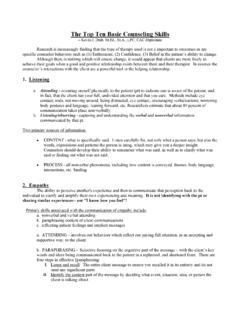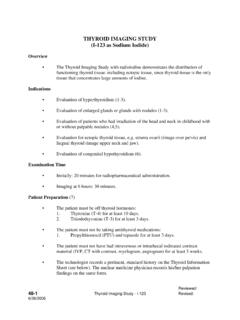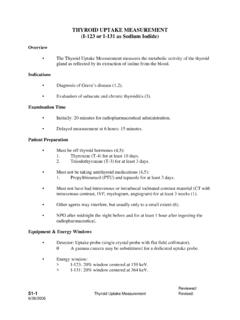Transcription of SEROTONIN AND BRAIN: EVOLUTION, NEUROPLASTICITY, …
1 SEROTONIN AND brain : evolution , NEUROPLASTICITY, AND HOMEOSTASISE frain C. AzmitiaDepartment of Biology and Psychiatry, Center for Neural Science, New York UniversityNew York 10003, USAI. IntroductionII. evolution : From Unicellular to HumansIII. Holistic brain Function Starts at DevelopmentIV. Homeostasis of BrainV. Clinical Implications of Loss of HomeostasisReferencesNeurotransmitters are chemicals released by the presynaptic endings ofneurons that have specialized actions through specific receptors on the mem-brane potential of postsynaptic neurons. However, these chemicals have morecomplex functions both within the neuron and on its varied cellular functions include changes in metabolic activities that have consequenceson the plasticity of the neurons.
2 SEROTONIN is an ancient chemical synthesizedfrom an indole-containing precursor, tryptophan. A review of the evolution ofthis chemical within biological systems helps appreciate its holistic actions onbrain homeostasis. In plants SEROTONIN and its allied indole-containing molecules5-hydroxytryptophan, auxin, and melatonin regulate many of the processesinvolved in cell diVerentiation: mitosis, migration, and maturation [Pasternaket al.(2005).J. Exp. Bot. 56, 1991 2001; Kolar and Machackova (2005).J. Pineal , 333 341]. In animals, in addition to these trophic properties, 5-hydroxy-tryptamine (5-HT) participates in most biological functions, especially those asso-ciated with limbic and brainstem circuits.
3 The precocious development in thecenter of the brainstem, its response to a plethora of stimuli and its extensiveconnection to all areas of the brain provide the framework for 5-HT contributionto holistic functioning of the brain . The fine anatomy of the axons and theirexquisite sensitivity to environmental trophic and toxic molecules encourages thedynamics of 5-HT innervation pattern and density. The ability to modify itself by aprocess called neuroplasticity makes it suited to serve as a regulator in brainhomeostasis, and predicts its involvement in many brain disorders, especially thoseconcern with depression and REVIEW OF31 NEUROBIOLOGY, VOL. 77 Copyright 2007, Elsevier rights : (06)77002-70074-7742/07 $ IntroductionThis chapter presents evidence that the neurotransmitter SEROTONIN (5-hydroxy-tryptamine, 5-HT) functions as a global factor involved in brain homeostasis.
4 Theearly appearance of 5-HT axons and their projections throughout the brain andspinal cord occurs prior to the diVerentiation of most neurons and their participationin functional circuits. The emphasis of the chapter will be on 5-HT s activation of the5-HT1 Areceptor to release the glial neurite extension factor, S100B. S100B acts tostabilize the microtubules which form the main framework of the cytoskeleton ofneural cells, including neurons and of the most dynamic and pervasive neuronal systems is the brainstemraphe serotonergic neurons. The actions of 5-HT on cellular metabolism, move-ment, and reproduction evolved from its first appearance in aerobic unicellularorganisms and plants to its current restricted neuronal localization in the brain -stem of humans.
5 In the most primitive organism, 5-HT acts within the cell toregulate cell oxidation largely due to its indole core structure, a unique ringconfiguration. The indole ring captures light energy and converts it to biologicalenergy by loss of an electron (oxidation). The indole ring is now an oxidizingagent and is reduced by absorbing an electron, usually from a metal ion. Theindole ring now functions as antioxidant by acting as a reducing agent thatcan easily lose this electron. In the cell, SEROTONIN , melatonin, auxin, and manyindole-alkaloids act as powerful antioxidants. In addition, 5-HT synthesis by thehydroxylase enzyme directly captures free oxygen and serves the important roleof reducing the concentration of this reactive the animal kingdom, while retaining this important antioxidant anddiVerentiating properties, 5-HT begins in crustaceans to influence higher brainfunctions such as dominance in a social grouping.
6 In the human brain , the 5-HTneurons from the raphe nuclei make connections innervating the entire brain andspinal cord, which builds on its functional impact to include a link in humansto interactions of 5-HT neurons with neuronal and nonneuronal systemsare covered with an emphasis on the diversity of the cells receiving released5-HT: neurons, glial cells, endothelial cells, ependymal cells, and endocrine diversity of these cellular targets argues for a broad function for 5-HT inbrain. The ability of 5-HT to promote brain plasticity and stabilization by actingon the cell cytoskeleton is discussed in the context of homeostasis. The importantaction of 5-HT on the 5-HT1 Areceptor in releasing the glial protein S100B is thebasis of this regulation of morphological plasticity.
7 The chapter, as a whole,supports the key idea expressed by Cannon in his discussion of homeostasisthat slight instability is the necessary condition for the true stability of theorganism. neuroplasticity is a necessary attribute of a homeostatic system, but32 EFRAIN C. AZMITIA early development and global interconnections make this system holistic in ability to change morphology, stimulate neurogenesis and diVerentiation, orpromote cell survival is influenced by acetylcholine, catecholamines, GABA,EAAs (glutamate and glycine), and neuropeptides. However, only SEROTONIN (5-HT) has the evolutionary and anatomical properties to serve as a globalregulator unifying the whole brain into a cohesive biological evolution : From Unicellular to HumansA delay in our appreciation of the diverse actions of neurotransmitterswas the focus on electrophysiology which dominated the study of the brain inthe early twentieth century.
8 The chemical substances released by neurons wereconsidered to be mediators of the electrical current across the synapse, thus theword neurotransmitters. The focus of many early neuroscience studies inthe twentieth century was to determine if neurotransmitters were excitatory orinhibitory electrical influences on the membrane potentials of postsynaptic by acting on specific receptors were considered to be iono-trophes capable of opening specific ion channels. They traveled in fixed circuitsand the notion of neurons and synapses being plastic was not considered until latein the 1950s (Liu and Chambers, 1958).The reality of the situation is neurotransmitters predate the formation ofnervous tissue.
9 SEROTONIN is found in all animals, plants, and most unicellularorganisms (Garattini and Valzelli, 1965). It is synthesized from the amino acidtryptophan by the action of two enzymes, tryptophan hydroxylase, and aromaticamino acid decarboxylase (Fig. 1). Tryptophan is synthesized by a variety ofenzymes (Zhao and Last, 1996). The creation of the indole structure served animportant function in the start of aerobic life on the earth. The conversion ofenergy (photons) derived from the sun into biological energy requires capturing alight wave and the loss of an electron. Interestingly, the indole ring is the mosteYcient molecule for doing exactly this and most sensitive to blue light (450 nm)(Borkman and Lerman, 1978).
10 Most proteins are endowed with an intrinsic UVfluorescence because they contain aromatic amino acids, specifically phenylala-nine, histamine, tyrosine, and tryptophan. Of these aromatic amino acids, tryp-tophan has the highest fluorescence quantum yield overshadowing markedlythe emissions of the other two. Tryptophan emission maxima in proteins can varyfrom 332 to 342 nm depending on the protein. Free tryptophan has a charac-teristic fluorescence emission at 350 360 nm (Borkman and Lerman, 1978).Absorption of blue light waves is able to excite the indole structure so that itloses one of the electrons from its indole ring structure, it becomes single electron begins a directed journey jumping from heavy metals toSEROTONIN AND brain : evolution , neuroplasticity , AND HOMEOSTASIS33finally produce reduced chemical cofactors, such as NADH and NADPH, andgenerates O2from H2O as a by-product.



















